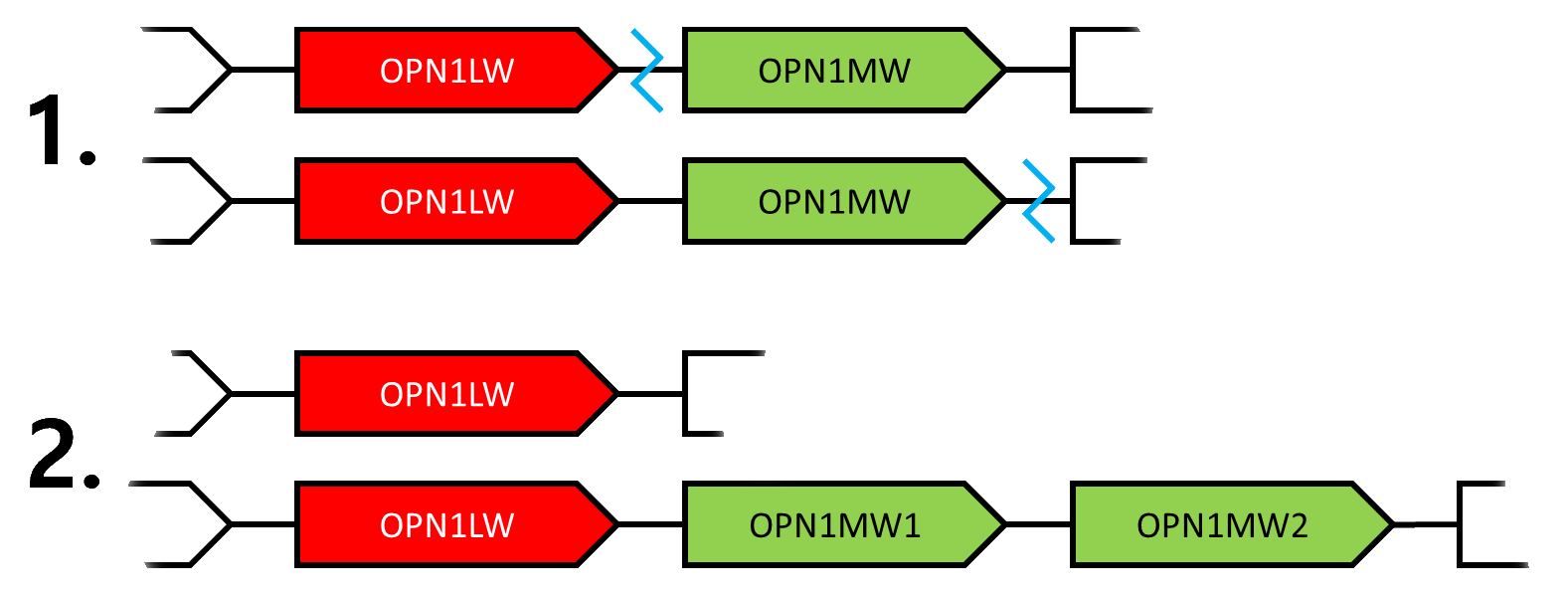|
OPN1MW
Green-sensitive opsin is a protein that in humans is encoded by the ''OPN1MW'' gene. OPN1MW2 OPN1MW2 is a duplication of the OPN1MW gene, which encodes the medium wavelength sensitive (MWS) photopsin. The gene duplication is present in about 50% of X-chromosomes, so is present in 50% of males and at least once 75% of females. It caused by ... is a similar opsin. See also * Opsin References Further reading * * * * * * * * * * * * * External links GeneReviews/NIH/NCBI/UW entry on Red-Green Color Vision Defects G protein-coupled receptors Color vision {{transmembranereceptor-stub ... [...More Info...] [...Related Items...] OR: [Wikipedia] [Google] [Baidu] |
OPN1MW2
OPN1MW2 is a duplication of the OPN1MW gene, which encodes the medium wavelength sensitive (MWS) photopsin. The gene duplication is present in about 50% of X-chromosomes, so is present in 50% of males and at least once 75% of females. It caused by the same mechanism that causes congenital red-green color blindness, the most common form of color blindness. Gene Duplication OPN1MW2 is a duplication of the OPN1MW gene arising from unequal homologous recombination. During this process, one of the X-chromosomes "donates" its OPN1MW gene to the other chromosome, resulting in: * One chromosome without a OPN1MW gene, which carries protanopia * One chromosome with two OPN1MW genes, although only the first gene in the chain (OPN1MW1) will generally be expressed and the second gene OPN1MW2 will remain unexpressed. The only difference between the two genes is their position in the gene cluster. They are equal in that they have the same chances of encoding a certain OPN1MW allele. However, ... [...More Info...] [...Related Items...] OR: [Wikipedia] [Google] [Baidu] |
Opsin
Animal opsins are G-protein-coupled receptors and a group of proteins made light-sensitive via a chromophore, typically retinal. When bound to retinal, opsins become Retinylidene proteins, but are usually still called opsins regardless. Most prominently, they are found in photoreceptor cells of the retina. Five classical groups of opsins are involved in Visual perception, vision, mediating the conversion of a photon of light into an electrochemical signal, the first step in the Visual phototransduction, visual transduction cascade. Another opsin found in the mammalian retina, melanopsin, is involved in circadian rhythms and Pupillary light reflex, pupillary reflex but not in vision. Humans have in total nine opsins. Beside vision and light perception, opsins may also sense temperature, sound, or chemicals. Structure and function Animal opsins detect light and are the molecules that allow us to see. Opsins are G-protein-coupled receptors (GPCRs), which are chemoreceptors and hav ... [...More Info...] [...Related Items...] OR: [Wikipedia] [Google] [Baidu] |
Protein
Proteins are large biomolecules and macromolecules that comprise one or more long chains of amino acid residues. Proteins perform a vast array of functions within organisms, including catalysing metabolic reactions, DNA replication, responding to stimuli, providing structure to cells and organisms, and transporting molecules from one location to another. Proteins differ from one another primarily in their sequence of amino acids, which is dictated by the nucleotide sequence of their genes, and which usually results in protein folding into a specific 3D structure that determines its activity. A linear chain of amino acid residues is called a polypeptide. A protein contains at least one long polypeptide. Short polypeptides, containing less than 20–30 residues, are rarely considered to be proteins and are commonly called peptides. The individual amino acid residues are bonded together by peptide bonds and adjacent amino acid residues. The sequence of amino acid residue ... [...More Info...] [...Related Items...] OR: [Wikipedia] [Google] [Baidu] |
Gene
In biology, the word gene (from , ; "...Wilhelm Johannsen coined the word gene to describe the Mendelian units of heredity..." meaning ''generation'' or ''birth'' or ''gender'') can have several different meanings. The Mendelian gene is a basic unit of heredity and the molecular gene is a sequence of nucleotides in DNA that is transcribed to produce a functional RNA. There are two types of molecular genes: protein-coding genes and noncoding genes. During gene expression, the DNA is first copied into RNA. The RNA can be directly functional or be the intermediate template for a protein that performs a function. The transmission of genes to an organism's offspring is the basis of the inheritance of phenotypic traits. These genes make up different DNA sequences called genotypes. Genotypes along with environmental and developmental factors determine what the phenotypes will be. Most biological traits are under the influence of polygenes (many different genes) as well as gen ... [...More Info...] [...Related Items...] OR: [Wikipedia] [Google] [Baidu] |
G Protein-coupled Receptors
G protein-coupled receptors (GPCRs), also known as seven-(pass)-transmembrane domain receptors, 7TM receptors, heptahelical receptors, serpentine receptors, and G protein-linked receptors (GPLR), form a large group of evolutionarily-related proteins that are cell surface receptors that detect molecules outside the cell and activate cellular responses. Coupling with G proteins, they are called seven-transmembrane receptors because they pass through the cell membrane seven times. Text was copied from this source, which is available under Attribution 2.5 Generic (CC BY 2.5) license. Ligands can bind either to extracellular N-terminus and loops (e.g. glutamate receptors) or to the binding site within transmembrane helices (Rhodopsin-like family). They are all activated by agonists although a spontaneous auto-activation of an empty receptor can also be observed. G protein-coupled receptors are found only in eukaryotes, including yeast, choanoflagellates, and a ... [...More Info...] [...Related Items...] OR: [Wikipedia] [Google] [Baidu] |




